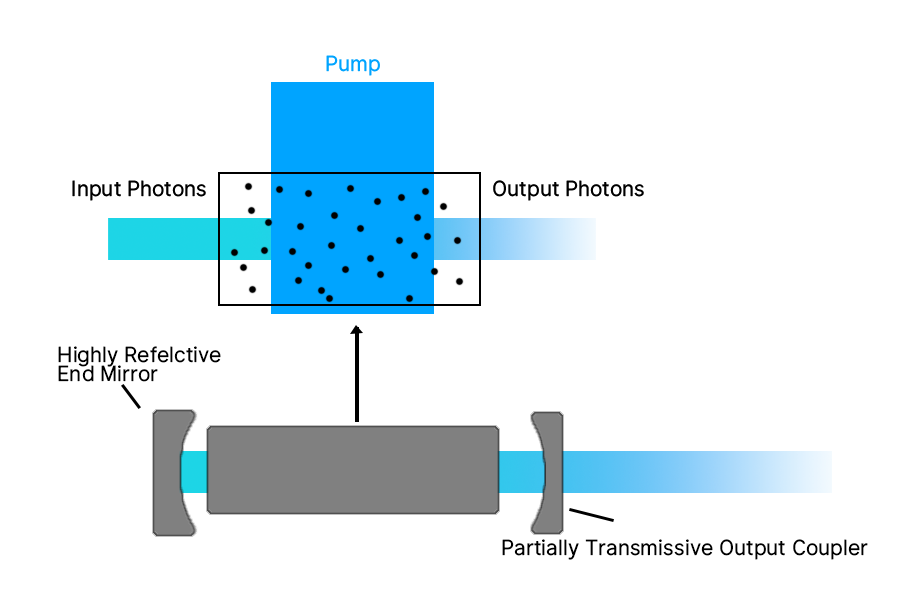Lasers, a cornerstone of modern technology, operate on principles of quantum mechanics. This article expands on the fundamental components of lasers, exploring the complex interactions and processes that enable their unique capabilities.
Component | Function | Examples |
Gain Medium | The gain medium is the material in a laser used for amplifying light. It facilitates light amplification through the process of population inversion and stimulated emission. The choice of gain medium determines the laser's radiation characteristics. | Solid-State Lasers: e.g., Nd:YAG (Neodymium-doped Yttrium Aluminum Garnet), used in medical and industrial applications. Gas Lasers: e.g., CO2 lasers, used for cutting and welding. Semiconductor Lasers: e.g., laser diodes, used in fiber optics communication and laser pointers. |
Pumping Source | The pumping source provides energy to the gain medium to achieve population inversion (the energy source for population inversion), enabling laser operation. | Optical Pumping: Using intense light sources like flashlamps to pump solid-state lasers. Electrical Pumping: Exciting the gas in gas lasers through electric current. Semiconductor Pumping: Using laser diodes to pump the solid-state laser medium. |
Optical Cavity | The optical cavity, consisting of two mirrors, reflects light to increase the path length of light in the gain medium, thereby enhancing light amplification. It provides a feedback mechanism for laser amplification, selecting the spectral and spatial characteristics of the light. | Planar-Planar Cavity: Used in laboratory research, simple structure. Planar-Concave Cavity: Common in industrial lasers, provides high-quality beams. Ring Cavity: Used in specific designs of ring lasers, like ring gas lasers. |
The gain medium is the central component where the laser amplification process occurs. It involves complex interactions between energy states and particles.

A simplified diagram of a laser, including the gain medium, pumping source, and the optical resonator mirrors with cavity length (d).
In the gain medium, the process of light amplification is governed by two key energy levels, with particle numbers N2 and N1. The transition cross-section σ21 plays a crucial role. The equation I = I0e^(σ21(N2-N1)L) describes the light intensity emerging from the medium. A population inversion, where N2 exceeds N1, is essential for light amplification. This inversion is achieved through various pumping mechanisms, each tailored to the type of laser and its intended application.
Practical laser systems often utilize more than two energy levels to facilitate easier population inversion. In three-level systems, particles are pumped from the ground state to a higher excited state and then transition to a metastable state where stimulated emission occurs. Four-level systems add an additional energy level, making population inversion more achievable due to the rapid non-radiative decay from this added level.
The pumping source is crucial for initiating the laser process by achieving population inversion in the gain medium.

Optical Pumping of Gain Medium Example: Semiconductor Laser Diode Pumping
Different lasers use various pumping mechanisms, such as optical pumping with lamps or lasers, electrical discharge in gas lasers, and electron injection in semiconductor lasers. These mechanisms are chosen based on the gain medium's properties and the desired laser characteristics.
In solid-state lasers, optical pumping is commonly used, where flashlamps or arc lamps provide the necessary energy. Semiconductor laser pumping, particularly in diode-pumped solid-state (DPSS) systems, offers higher efficiency and compactness, making it a popular choice in modern laser design.
Explore our diverse range of pump sources, featuring efficient and practical diode pumped solid state laser (DPSS) , high-performance fiber-coupled lasers, and powerful laser diode stacks (bar stacks). Each product in our lineup is meticulously designed to meet the specific needs of your applications. For instance, our fiber-coupled lasers excel in precision control and superior heat dissipation, making them ideal for high-performance demanding scenarios. Click here to delve into the details of our products and discover the laser solution that best fits your needs.
Recommended Reading:
Laser Diodes and Bar Stacks: Definitions, Types, and Applications Explored
In-Depth Analysis: The Principles and Applications of Laser Pumping
Introduction to Solid-State Lasers: Basics, Types, and Applications
The optical cavity or resonator is responsible for shaping and refining the laser beam.
The cavity typically consists of two mirrors: a highly reflective mirror and a partially transparent output coupler. The design of these mirrors, including their alignment and curvature, is critical for the stability and mode structure of the laser. The cavity's role is to enhance the optical gain and reduce beam divergence, contributing to the laser's collimated and coherent output.
For laser oscillation to occur, the optical gain must exceed the total losses within the cavity. Additionally, the cavity must support coherent wave superposition, allowing only certain longitudinal modes to oscillate. The spacing of these modes is determined by the cavity's length and the properties of the gain medium.
Disclaimer:
We hereby declare that certain images displayed on our website are collected from the internet and Wikipedia for the purposes of furthering education and sharing information. We respect the intellectual property rights of all original creators. These images are used with no intention of commercial gain.
If you believe that any content used infringes upon your copyrights, please contact us. We are more than willing to take appropriate measures, including removing the images or providing proper attribution, to ensure compliance with intellectual property laws and regulations. Our aim is to maintain a platform that is rich in content, fair, and respectful of others' intellectual property rights.
Please reach out to us via the following contact method, email: sales@lumispot.cn. We commit to taking immediate action upon receipt of any notification and ensure 100% cooperation in resolving any such issues.
Contact: Lumispot
Phone: +86-15072320922
Tel: +86-510-87381808
Email: sales@lumispot.cn
Add: Bldg 4 No.99 Fu Rong 3rd Road, Wuxi, China